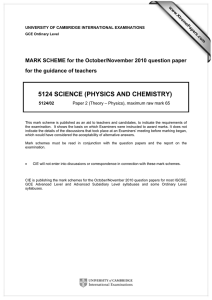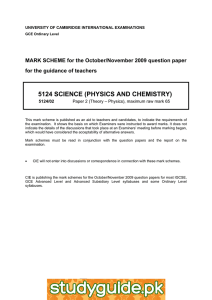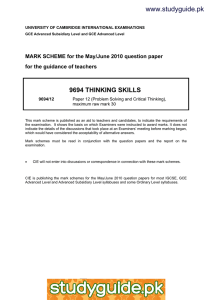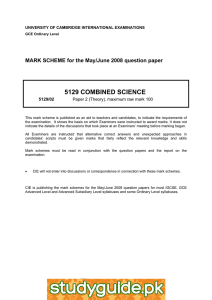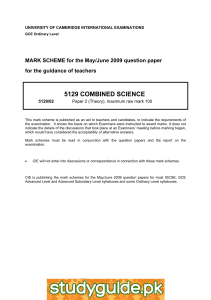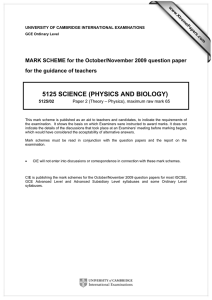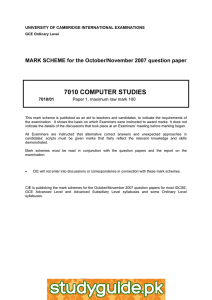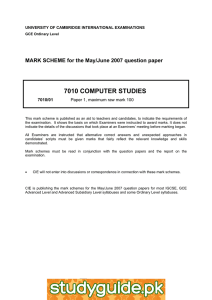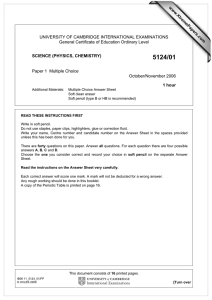5124 SCIENCE (PHYSICS AND CHEMISTRY) for the guidance of teachers
advertisement
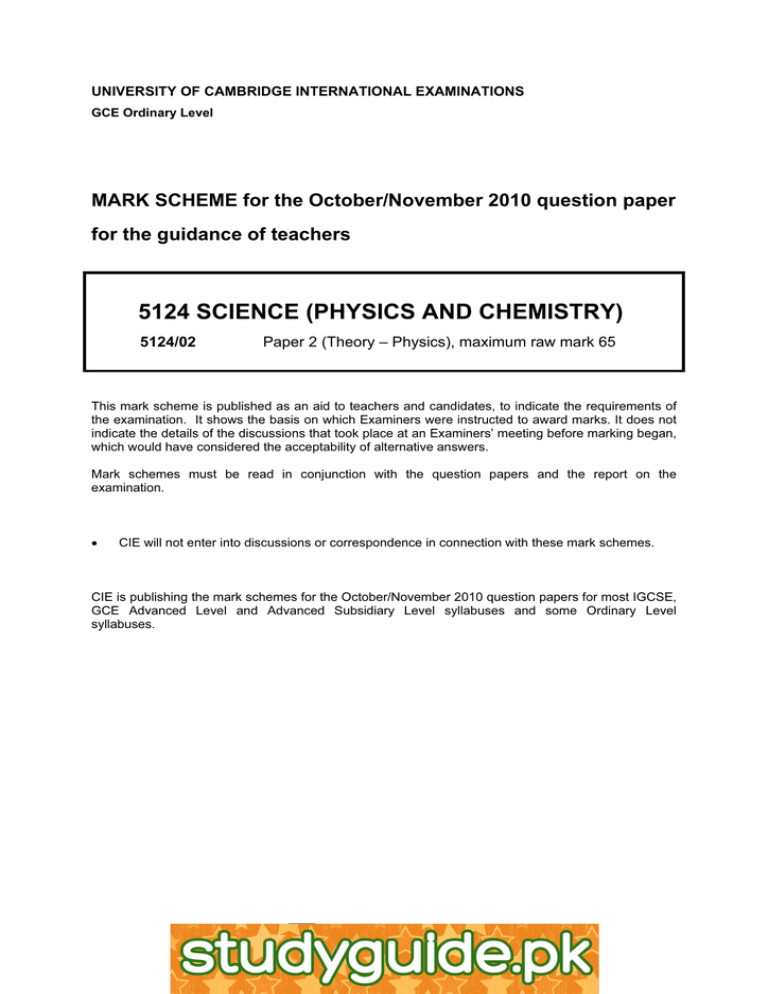
UNIVERSITY OF CAMBRIDGE INTERNATIONAL EXAMINATIONS GCE Ordinary Level MARK SCHEME for the October/November 2010 question paper for the guidance of teachers 5124 SCIENCE (PHYSICS AND CHEMISTRY) 5124/02 Paper 2 (Theory – Physics), maximum raw mark 65 This mark scheme is published as an aid to teachers and candidates, to indicate the requirements of the examination. It shows the basis on which Examiners were instructed to award marks. It does not indicate the details of the discussions that took place at an Examiners’ meeting before marking began, which would have considered the acceptability of alternative answers. Mark schemes must be read in conjunction with the question papers and the report on the examination. • CIE will not enter into discussions or correspondence in connection with these mark schemes. CIE is publishing the mark schemes for the October/November 2010 question papers for most IGCSE, GCE Advanced Level and Advanced Subsidiary Level syllabuses and some Ordinary Level syllabuses. www.XtremePapers.net Page 2 Mark Scheme: Teachers’ version GCE O LEVEL – October/November 2010 Syllabus 5124 Paper 02 Section A 1 2 (a) 7000 (1) [1] (b) 0.007 (1) [1] (a) (i) use of F = ma (1) 40 (N) (1) [2] (ii) weight / gravity AND drag / air resistance / friction (1) (BOTH needed in either order) (b) drag / air resistance / friction increases (1) 3 (a) 36 Accept value in the range 15.5 to 16.5 [1] all correct (1) (b) use of density = mass ÷ volume (1) 2.25 (g/cm3) allow error carried forward from incorrect (a) (1) (c) the solid may dissolve in water / solid may float / solid could react with water (1) (do NOT accept “water might evaporate” OR “water is absorbed) 4 (a) use of change of speed divided by time (1) 1.25 (m/s2) (1) (b) use of area under graph OR average speed × time (1) EITHER 40 OR 60 (distance for 1 part of the graph) (1) 100 (m) (1) (allow 1 mark only if the correct answer is given without working) 5 [1] [1] [2] [1] [2] [3] (c) use of total distance divided by time (1) 7(.1428) Allow ecf from incorrect (b) (1) [2] (a) (i) normal drawn and both angles labelled correctly (1) [1] (ii) sin i divided by sin r (1) [1] (iii) ray drawn roughly parallel to the incident ray (1) [1] (b) use of sines for both angles (0.8987 AND 0.6427) (1) 1.4 (accept 1.39…) [NOT 1.6] (1) (allow both marks if the correct answer is given) © UCLES 2010 www.XtremePapers.net [2] Page 3 6 Mark Scheme: Teachers’ version GCE O LEVEL – October/November 2010 Syllabus 5124 Paper 02 (a) (i) from nuclei in the sun / nuclear reactions / nuclear energy / fusion (1) (ii) by radiation / as electromagnetic waves (1) (b) (i) em / light / solar TO electrical (BOTH needed) (1) (ii) electrical TO kinetic / movement / mechanical (BOTH needed) (1) 7 (a) circuit diagram (with appropriate symbols) showing 2 resistors in parallel connected to a battery (1) 1 product 1 1 = + OR (1) R sum R1 R2 6 (Ω) (1) [1] [1] [1] [1] [1] (b) use of [2] V (1) R 1.3(3) (A) (1) [2] (ii) use of P = IV (1) 16 (W) (1) [2] (c) (i) use of I = 8 9 (a) 4½ (kWh) (1) 180 c or $1.80 (1) [2] (b) normal working current is more than this (about 12 A) (1) So fuse would blow when it is switched on / working normally (1) (NOT just “fuse would blow”) [2] Either a large bulb / large amount of mercury (1) Increase the volume change for a given temperature change (owtte) (1) Or a thin capillary / tube (1) So greater movement of mercury for a given temperature change (1) [2] 10 (a) 8 (1) [1] (b) β / beta radiation (1) mass number remains the same OR proton number increases (by 1) (1) (the second mark is dependent on the first being correct) 11 heated air is less dense / expands (1) it rises (and is replaced by cooler air) (1) process repeated / convection current occurs (1) © UCLES 2010 www.XtremePapers.net [2] [3] Page 4 Mark Scheme: Teachers’ version GCE O LEVEL – October/November 2010 Syllabus 5124 Paper 02 Section B 12 (a) beam / metre rule balanced by / on a pivot (1) masses / weights added to each side until the beam balances (1) distances between weights and pivot are measured (1) repeated with different weights / distances (1) moment = force × distance (from pivot) AND indication that they should be equal (1) (b) moment = 25 × 30 (1) (do not award if e.g. WD or F = ma quoted) moments equated (1) 37.5 cm (1) (c) low centre of gravity (1) needs to move a great distance to topple (1) (or words to that effect) 13 (a) an arrangement for the simultaneous emission of sound and light e.g. a starting pistol (1) start stop watch / clock when flash / smoke is seen and stop when sound is heard (1) measure distance between observer and source using a sensible method (1) distance of at least 500 m (1) speed calculated using distance divided by time (1) (allow a suitable echo method) [5] [3] [2] [5] (b) vibrations passed from particle to particle (1) by compressions and rarefactions / longitudinal wave OR good description (1) [2] (c) use of distance = speed × time (1) 66 (m) (1) 33 m (1) [3] 14 (a) apparatus that allows relative motion between a wire / coil and a magnet with the wire / coil connected to an ammeter / voltmeter / galvo (1) movement of wire / magnet gives a reading on the meter (1) change of speed / field / number of turns (1) gives changed e.m.f. / reading (1) change in e.m.f. consistent with their change (1) [5] (b) use of correct formula (1) Correct substitution OR turns ratio = 40 (1) 6 V (1) [3] (c) steel retains magnetism; iron does not OR iron easily magnetised / steel is not (1) Iron produces stronger magnet (1) [2] © UCLES 2010 www.XtremePapers.net
